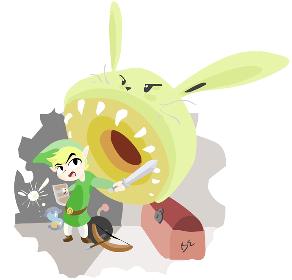In the DS Design entry on control, I briefly covered examples of games that utilize blowing into the mic for a control method. What's important to note is that for many of these games, the blowing input has many degrees of control making it an analog input. In other words, blow softly for a little wind, and blow hard for a gale.
From the beginning of the DS's life, a popular (or should I say unpopular) use for the DS mic was for blowing. Blowing usually created wind to...
- move rafters (Feel the Magic XY/XX)
- inflate up baloons (Mario Kart DS)
- power fan blade cars (Wario Ware Touched)
- blow away clouds (Yoshi's Touch & Go)
- cool off buring guitars (Guitar Hero: On Tour)
- start a fire (The Sims 2: Castaway)
- help Yoshi fly (New Super Mario Brothers)
- cool food (Cooking Mama)
- blow off dust (Trace Memory)
- etc.
Another unique design feature of microphone controls is that they can be sneaked into the design of a game without the player being aware. For traditionally controlled games, players can use any combination of the DS's buttons. For the more innovative, next-gen, DS specific controls, players use the touch screen or some combination of touch screen and buttons. But for either of these control schemes, the microphone is always present and "turned on" adding another possible input. Because you never push a button or touch the microphone to use it, it's easy to forget about. In fact, you could be affecting a game just by the ambient sounds in the room. Subtle mic implementation is similar to designing motion controls for the PS3. Most players expect a gaming experience with the typical button/stick based control scheme. Throw in a bit of motion controls, and you can create some real surprises. MGS4 did a good job of this.
The following games have implemented mic functionally into their game very subtly.

- Defeating a special enemy (Phantom Hourglass): This large, yellow, rabbit eared enemy (see above) is invulnerable to all of Link's attacks. But there was something about its big ears that tipped me off. Though Link is a mute character, using the DS mic I could give him a voice. A voice to haggle prices, blow dust, and even shout in the ears of my enemies. Though the mic is used sparingly throughout the game, these moments were very memorable. By making some noise, this enemy goes on the defensive making it vulnerable to my sword.
- Shhhhh (Wario Ware Touch): There is at least one micro game that you must keep quiet for. After playing with the DS touch screen for the majority of the game, encountering a microphone only game is rare let alone one that wants you to essentially not use the mic. Who knew stifling one's outcries could be so entertaining.
- Bird Calling (Ninja Gaiden: Dragon Sword): Controlling Ryu is all handled with the touch screen. Occasionally you'll hear birds calling somewhere of the screen. You can imagine my surprise when the bird came out of hiding after I mimicked its bird call. I thought I was simply mimicking sounds from the game. It turned out I was using my voice to activate a secret. Well done Itagaki. Well done.
The DS mic has many more creative uses that extend far beyond gameplay controls.
- Voice chat (Advance Wars: Days or Ruin, Metroid Prime Hunters, Pokemon): Hit a button. Talk to your friends over the internet. Simple.
- Voice Acting Modulator (Star Fox Command) By recording a sample of your voice, the game can create a modulated character voice in the same style of the pre recorded characters in the game that harken back to the voices of the SNES Star Fox characters. It's creative, innovative, and classic all at the same time.
- Level Sharing (Bangai-O Spirits): Instead of buying severs and creating a wifi interface so players around the world can share their custom Bangai-O levels, Treasure did something truly innovative. In Bangai-O, players can export their level data as a sound file. By recording this file, players can save and upload their levels however they want. Got a website? Host it there. Youtube? Upload your sound file as a movie. The versatility is unmatched. To download a level, simply hold the speaker playing the audio file up to the DS microphone.
- Record, Play Back, and Manipulation (Electroplankton) Like the Yak Bak or Talkboy, Electroplankton allows players to record their voices and manipulate the audio in various ways before playing it back again. I've never gotten tired trying to record a phrase backwards to see if it sounds right in reverse forwards. Gnimag-lacitirc!
- Karaoke, Note Locator, Song Converter (Diagasso Band Brothers 1 & 2): Sing into the mic and keep to the correct pitches like in Guitar Hero/Rock Band/Sing Star. If you're trying to pin point a specific note, you can sing/play it and the game will tell you what note you're searching for. Trying to write a song? If you can sing/play the notes, the game will notate it as accuratley as it can.
There are many more examples, but they all fall into the categories detailed above. So, I'll end this entry with that. I hope you don't have an...
